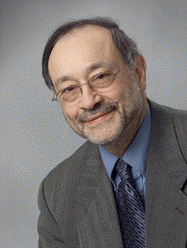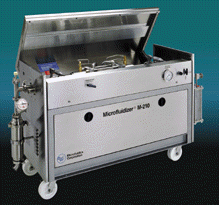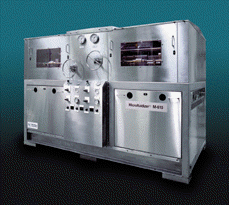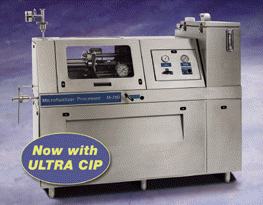|
|
MFIC Corporation (MFIC) |
|
CEOCFO
Interview Index |
This is a printer friendly page! MFIC Corporation has completely
re-engineered the financial position of their company with the sale of their mechanical
mixer division, completion of a $2,900,000 financing, elimination of net debt, and
availability of over $2,000,000 to invest in marketing/sales, R&D and senior
infrastructure Bio of
CEO,
Mr. Gruverman is a Professional Engineer, with
substantial experience in radioisotope applications in medicine and industry, and the
application of chemistry, biotechnology, physics and engineering disciplines to
commercial opportunities.
He is a graduate of The Cooper Union (B.S. Chem. Engg. -
1954) and MIT (M.S. Nucl. Engg. - 1955), and has completed post-graduate executive
management courses. Mr. Gruverman has applied a knowledge of venture funding approaches
and public financing to launching and/or financing of more than 60 technology-based
enterprises.
He has authored more than 100 technical articles,
presentations and papers, mainly in the fields of isotope methodology, engineering
applications, biotechnology applications in medicine, agriculture and the chemical
industry, and analysis of business/high technology funding options. Mr. Gruverman is
a member of Sigma Xi (Experimental Science Society), Tau Beta Pi (Engineering Honor
Society), American Chemical Society, Society of Nuclear Medicine, and other professional
groups. The Microfluidics Division manufactures 3 levels of
Microfluidizer® material processors; laboratory, pilot manufacturing and large
scaleup production units. Processors offer operating pressures from 2,500 psi up to 40,000
psi in applications ranging from industrial processing of chemicals, inks and pigments to
cleanroom applications for manufacture of injectible drugs and vaccines. These include
Homogenizers, Table Tops and Floor Models. The scaleup processors include the M700 and
M710 Series, the M210EH electric-hydraulic processors and the custom designed M610
processor. New Products and Applications: MFIC Corporation has introduced a new, patented
High-Pressure Microfluidizer MicroReactor, (MMR) from their Microfluidics Division. It
produces uniform nanoparticles with phase purity previously unachievable with conventional
batch reaction technology. This degree of reaction chemistry control can lead to
cost-effective product improvements and the development and manufacture of new
nanomaterials in scalable quantities. Applications for the new technology include
improving the performance of catalysts, planarization polishing media, superconductors,
abrasive silica, recording media, photographic media and pigments. It also may be used in
the development and production of unique pharmaceutical products, particularly for
solubilizing pharmaceutical actives which are difficult to formulate. These are
nanoparticle suspensions or other nanostructured materials, with potential use in
injectables, transdermals, topicals, inhalation agents, intranasal and oral formulations. The Microfluidics Division has announced new and significant products and product advancements and options for their Microfluidizer processor systems. The most recent and significant announcement was the introduction of the new M710 Microfluidizer high throughput production processor system. This 100 H.P variant of the established M700 line has materially enhanced Microfluidics’ competitive position in terms of pricing and performance in all industries and applications that the company serves. In addition to biotechnology and pharmaceutical production, this product targets markets such as foods, chemicals and personal care, by offering pricing that is competitive with traditional homogenizers. The new M700 Microfluidizer Containment System is utilized for the processing of highly toxic cancer drugs and other hazardous materials. The M700 Microfluidizer Split System (separating the power source from the mixing/processing apparatus) accommodates demands of limited space within clean rooms and for noise abatement within pharmaceutical production facilities. In conjunction with this system, a Level II Steam Sterility Option was also introduced for all our pilot and production systems used for production of injectable and other pharmaceuticals. This option enables compliance with stringent regulatory production requirements. The Ultra Clean in Place (UCIP) option improves the ability to clean in place (CIP) Microfluidizer processor systems between product batch runs or before storage. This capability differentiates the company’s Microfluidizer materials processor systems from all other competitive products. All these features and options are available on the M-710 production systems. CEOCFOinterviews: Mr. Gruverman, your products are sold into various industries, in which industries would you say that you have made the greatest inroads this year, and what would you attribute that to? Mr. Gruverman: “Our
biggest customer base is in the biotech and pharmaceutical industries. About eighty
percent of our sales are to those industries. We have made some progress in the food
industry in areas such as soymilk manufacturing and nutraceuticals. Soymilk
producers like our process because it produces a better product in terms of texture and
taste, as well as being able to incorporate much more of the soy fiber into the product.
That makes a better product as well as doing away with a large waste problem. We think we
are going to make some progress there. We are continuing to focus on biotech and
pharmaceuticals and to extend our reach further into that area. CEOCFOinterviews: Will Dr. Beltz be active in that area as well or just the biotech area? Mr. Gruverman: “He
will focus primarily on pharmaceuticals and biotech; but he will do some work in these
other areas. We are planning next year to hire another specialist at a similar competence
level to address either food or the chemical industry. We will probably get specialists
for both over time. This is enabled by the fact that we sold our Morehouse-COWLES
division, which was losing a lot of money. We immediately became profitable and started
generating substantial cash-flow in addition to which we were fortunate in being able to
complete a private placement of equity and raised about 2.9 million dollars net. That got
us out of debt and gave us two million dollars in cash, which is available to invest in
critical areas. It has also permitted us to change our banking relationship so that we
have a million dollars of long-term debt and a convenient revolving credit line. That puts
us into an advantageous economic position and makes available the financial resources to
expand our marketing sales and to increase our R&D effort dramatically to try to
create enhancements for our core line of Microfluidizer® equipment, as well as
to continue to improve on the new technology, that we developed specifically for
nanoparticle manufacture. It is called an MMR, which now stands for Microfluidizer®
MicroReactor. What we do in that equipment is to conduct chemical reactions under intense
ultraturbulent conditions to create nanoparticle reaction products. This has begun to play
out quite well; we haven’t sold any equipment yet but we have demonstrated it and
customers are getting enthusiastic. It is really a disruptive technology in the sense that
it is going to allow people to make better product at less capital and operating costs and
with better control of their production process. Thus, we need to continue our missionary
selling efforts to disseminate knowledge of this new approach. CEOCFOinterviews: The last time we spoke, you mentioned that you were constrained by your financial structure; you have managed to clear that up, which is great news. You also mentioned that somehow the R&D and growth of the MMR product was hinged on the interest of the people you were marketing to and selling to. You have made headway in infrastructure. You also felt that the interest in the MMR product would affect the need to increase R&D spending. Do you still feel that way? Mr. Gruverman: “Very
much so. We have hired three new people to bring forward our MMR development work. One of
them has been active for eighteen months and she heads the R&D effort, Mimi
Panagioutou is a PhD chemical engineer with a background in nanotechnology and is leading
the charge here. I help here to the extent that I can. She has three people working with
her, all of whom are professionals with some background in this area. We are doing many
demonstrations for potential users. We are doing several in-house projects designed to
showcase the technology in publications. Generally, the projects we do for other people
have been successful but we are prohibited from saying anything about them. They have
mainly been in the biotech and pharmaceutical area. We are in the process of negotiating
arrangements with a catalyst manufacturer and other groups outside the healthcare space.
We really do think we are getting some traction. It is likely that we will have a sale of
our first major unit sometime next year.” CEOCFOinterviews: Do you see the future growth of MFIC in your MMR product? Mr. Gruverman: “In part. We see growing to be a $30-$50 million company from the present $11-$12 million level in three to five years. That is mainly projecting the core business. The MMR potential, I believe, is far greater than that. I can’t state the magnitude or the time scale. We don’t see any viable competition in the MMR space, but it is early days and there are other clever people in the world besides us. There is likely to be some competition. We are hoping to be able to value price the equipment because of the competitive advantage users will recognize. It is likely to be a strongly profitable line. What is different from when I talked to you last November is that we do have the resources to proceed without a lot of fear. At that time, we were putting small amounts of money into MMR and particularly into promoting it in the marketplace. We are doing much more of that now. We hired a consultant, Robert J. Fisher, Ph.D. from MIT’s (Massachusetts Institute of Technology) Soldier Nanotechnology Center; he is well qualified and I think he will help drive acceptance.. If the overall sales go the way we think they will and the margins are stable or improve, we will be able to hire a specific product manager for the MMR technology and that will also help. Generally speaking, there is more activity now than back in November (2003), largely because of our own efforts. I would say we now have in-house more than a hundred qualified leads for potential users who have expressed serious interest in continuing to look at MMR. Many of them have scheduled or are going to schedule demonstrations to prove the efficacy of the system in their particular application.” CEOCFO interviews: Are you the only company out there trying to produce this type of technology? Mr. Gruverman: “There are a few other companies. One of them has talked about it widely and has raised a lot of venture money. Their technology is based on some concepts that we tried several years ago and were unable to make them work on a practical scale. There are many smart people out there and some may build competitive systems, which do not infringe our strong patent position. I think that we have a several year lead in any case. There is another company that is doing similar things; but they operate at much lower pressures and they are not likely to be able to be competitive on production capacity or size/uniformity performance. Today, I don’t see any serious competition but that is not to say it cannot happen.” CEOCFOinterviews: In your core Microfluidizer processor business you have various areas and industries that your product is sold into. Which dominates that? Mr. Gruverman: “The big applications right now are the biotechnology/pharmaceutical space, however, coatings and particularly ink-jet ink are also very strong. Our equipment is dominant in manufacturing high quality ink-jet inks. That continues to be the case and that is a growing area. We are starting to find other manufacturers of ink-jet inks that are beginning to adopt our equipment, that haven’t in the past. That has happened not only in the United States but also in Asia. In the U.S., we are finding that some of the inkjet cartridge refillers are starting to adopt our technology as well. Another important area for us is biotechnology. Most biotech companies own a Microfluidizer® processor for cell disruption applications. The process is high tield, clean, is harmless to the proteins, is continuous and can be scaled up readily. I don’t think there is any other technology that has ever been used that can meet all these criteria. We are dominant in that space as well; we have a little competition that is coming on but we enjoy a major share of that market. As far as using the equipment in the pharmaceutical industry to manufacture regulated products, there are quite a few microemulsion applications that are in routine manufacturing. One of them is an injectible anesthetic that is widely used. Several manufacturers make it and almost all of them use our equipment. The manufacture of soymilk may become a major application for our equipment. In the food industry our equipment is being used to manufacture flavoring agents and other additives to foods. I think more applications will come on-line. There are many texture-controlled foods, such as low-fat yogurts where people are trying to create products that have a “mouth-feel” like fat that are actually soy protein; our equipment is capable of doing that. I think we are making progress there and we will be able to sell more equipment into the food industry.” CEOCFOinterviews: What about vaccines? Mr. Gruverman: “Some of the anti-terror vaccines are being made on our equipment. They are basically microemulsions and our equipment can probably make better and more stable microemulsions than competitors. Several of the major antiterrorism-vaccine companies are making their product on our equipment.” CEOCFOinterviews: You have made some strides! Mr. Gruverman: “Yes we think we have! We believe our equipment is superior; and we can demonstrate it. One interesting thing that has happened in the last few years is that we now own the technology of a key component used in our manufacturing equipment. Prior to this, we have had to buy a proprietary intensifier component, which is the most expensive part of the system, from another company. This hurt our pricing in competing with lower performance systems like homogenizers in manufacturing systems. Today we are competitive price-wise since we now own the key component technology. It is more reliable technology as well as being superior in many performance and maintenance aspects, to the technology that we had been using, as well as less costly to the end user.” CEOCFOinterviews: How and when did that come about? Mr. Gruverman: “We developed the technology internally. We first began implementing it about three years ago but it didn’t gain any significant traction until about a year to a year-and-a-half ago. We are seeing that accelerating as people are realizing that they can now get the high performance of a Microfluidizer® processor for the cost of the homogenizer. That is exciting for our sales people and causing some top-line growth. We have done a lot to enhance our top-line and we have done some major things to enhance our bottom-line including this development of in-house capability for making large equipment components. Even more important was the sale of our mechanical mixer division, Morehouse-COWLES. That division was unprofitable and this masked the fact that our underlying Microfluidizer® processor business was growing and turning out profits at very acceptable rates. We have transformed our financial position and regained the ability to make investments in our Microfluidics core business.” CEOCFOinterviews: How did the sale of your Morehouse-COWLES division come about? Mr. Gruverman: “We spent several years trying to find an appropriate buyer and we found one that would make something of it that we could never have done, partly because they use a lot of the equipment internally.” CEOCFOinterviews: Do you ever look at acquisitions? Mr. Gruverman: “Obviously
we do; we are a public company and we have an obligation to look at opportunities when
they are presented. We are not very proactive about that because of the bad result with
Morehouse-COWLES. We are finally out from under that. What I would like to do is show the
earning power of this company now that we have some capital and don’t have that drag
on earnings and we are going to do that. Having said that, if the right situation came
along and it was synergistic and most importantly, if it was accretive to earnings, we
would certainly take a hard look at it. I think we are capable of raising capital at this
point. I think our stock is undervalued. We are trying make clear to investors that our
prospects and performance are greatly improved. One of the reasons we believe that our
stock is not being paid more attention is the fact that we are a Bulletin Board company
and many brokers do not pay attention to that type of company. CEOCFOinterviews: So looking at MFIC you can see growth, a management team that has an idea of what they need to do to improve the profitability of the company and the cash flow levels. Mr. Gruverman: “I certainly would say yes.” CEOCFOinterviews: Before
we close is there anything about your management team that you would like to add?
Mr. Gruverman: “We
have beefed up our management team considerably over the last few months because we can
now afford to hire the kind of people we need. More importantly, they want to come here to
participate in a great technology opportunity, which is adequately funded. We have the
financial stability to attract the quality people that we have always been looking for. In
recent months we have hired a vice president of engineering, Chris Werner, which has
helped in developing advancements, reliability and wear characteristics of critical system
components. All of that is progressing rapidly under his leadership. CEOCFOinterviews: What would you like people to remember about MFIC? Mr. Gruverman: “I
would like to stress the value proposition that we represent. I talked a lot about our
restructured business and how well it is doing and how well it is projected. I think it is
important to understand that we are the only experienced manufacturer of equipment in the
nanotechnology space, so we probably are the premier supplier that can provide
manufacturing capacity when nanotechnology becomes a major activity. I think we are going
to be the leader in enabling manufacture of the nanoparticles and other nanostructures
that will be required. We have a doable battle plan where we restructured ourselves and
have put ourselves in position to benefit from the nanotech expansion. Finally, our core
Microfluidizer processor business is robust and can be expected to grow and generate
strong profits and cash flow.” |
“Our biggest customer base is in the biotech and pharmaceutical industries. About eighty percent of our sales are to those industries. We have made some progress in the food industry in areas such as soymilk manufacturing and nutraceuticals. Soymilk producers like our process because it produces a better product in terms of texture and taste, as well as being able to incorporate much more of the soy fiber into the product. That makes a better product as well as doing away with a large waste problem. We think we are going to make some progress there. We are continuing to focus on biotech and pharmaceuticals and to extend our reach further into that area.” - Irwin Gruverman |
|
|
|





